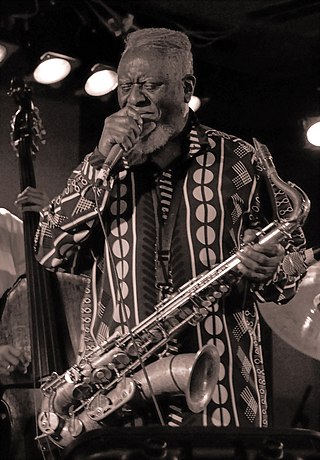
Pharoah Sanders was an American jazz saxophonist. Known for his overblowing, harmonic, and multiphonic techniques on the saxophone, as well as his use of "sheets of sound", Sanders played a prominent role in the development of free jazz and spiritual jazz through his work as a member of John Coltrane's groups in the mid-1960s, and later through his solo work. He released more than thirty albums as a leader and collaborated extensively with vocalist Leon Thomas and pianist Alice Coltrane, among many others. Fellow saxophonist Ornette Coleman once described him as "probably the best tenor player in the world".

Milford Graves was an American jazz drummer, percussionist, Professor Emeritus of Music, researcher/inventor, visual artist/sculptor, gardener/herbalist, and martial artist. Graves was noteworthy for his early avant-garde contributions in the 1960s with Paul Bley, Albert Ayler, and the New York Art Quartet, and is considered to be a free jazz pioneer, liberating percussion from its timekeeping role. The composer and saxophonist John Zorn referred to Graves as "basically a 20th-century shaman."
Joseph Jarman was an American jazz musician, composer, poet, and Shinshu Buddhist priest. He was one of the first members of the Association for the Advancement of Creative Musicians and a member of the Art Ensemble of Chicago.
William Godvin "Beaver" Harris was an American jazz drummer who worked extensively with Archie Shepp.

Don Gabriel Pullen was an American jazz pianist and organist. Pullen developed a strikingly individual style throughout his career. He composed pieces ranging from blues to bebop and modern jazz. The great variety of his body of work makes it difficult to pigeonhole his musical style.

Marion Brown was an American jazz alto saxophonist, composer, writer, visual artist, and ethnomusicologist. He was a member of the avant-garde jazz scene in New York City during the 1960s, playing alongside musicians such as John Coltrane, Archie Shepp, and John Tchicai. He performed on Coltrane's landmark 1965 album Ascension. AllMusic reviewer Scott Yanow described him as "one of the brightest and most lyrical voices of the 1960s avant-garde."

European free jazz is a part of the global free jazz scene with its own development and characteristics. It is hard to establish who are the founders of European free jazz because of the different developments in different European countries. One can, however, be certain that European free jazz took its development from American free jazz, where musicians such as Ornette Coleman revolutionised the way of playing.
The New York Art Quartet was a free jazz ensemble, originally made up of saxophonist John Tchicai, trombonist Roswell Rudd, drummer Milford Graves and bassist Lewis Worrell, that came into existence in 1964 in New York City. Worrell was later replaced by various other bassists, including Reggie Workman, Finn Von Eyben, Harold Dodson, Eddie Gómez, Steve Swallow, and Buell Neidlinger. All About Jazz reviewer Clifford Allen wrote that the group "cut some of the most powerful music in the free jazz underground".
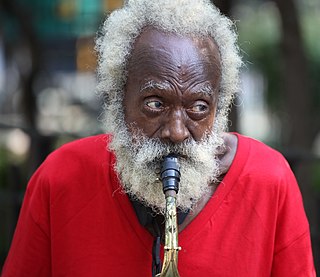
Giuseppi Logan was a jazz musician, originally from Philadelphia, Pennsylvania, who taught himself to play piano and drums before switching to reeds at the age of 12. At the age of 15 he began playing with Earl Bostic and later studied at the New England Conservatory. In 1964 he relocated to New York and became active in the free jazz scene.
John Corbett is an American writer, musician, radio host, teacher, record producer, concert promoter, and gallery owner based in Chicago, Illinois. He is best known among musicians and music fans as a champion of free jazz and free improvisation. In recent years he has become known in the visual art world as well through his Corbett vs. Dempsey gallery.

Donald Moye, Jr., known as Famoudou Don Moye, is an American jazz percussionist and drummer. He is most known for his involvement with the Art Ensemble of Chicago and is noted for his mastery of African and Caribbean percussion instruments and rhythmic techniques.
Clifford Edward Thornton III was an American jazz trumpeter, trombonist, political activist, and educator. He played free jazz and avant-garde jazz in the 1960s and '70s.
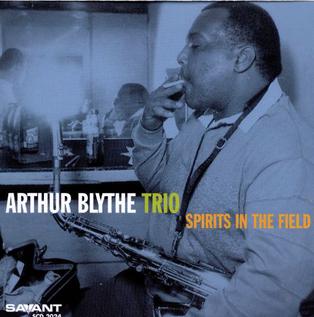
Spirits in the Field, is a live album by saxophonist Arthur Blythe, recorded at Bimhuis in Amsterdam in 1999 and released on the Savant label the following year.

Sonny's Time Now is an album by American free jazz drummer Sunny Murray, his first as a leader. It was recorded in New York City on November 17, 1965 and first released on LeRoi Jones' Jihad label. It was later reissued on the DIW and Skokiaan labels.

The New Wave in Jazz is a live album recorded on March 28, 1965 at the Village Gate in New York City. It features groups led by major avant-garde jazz artists performing at a concert for the benefit of The Black Arts Repertory Theater/School founded by Amiri Baraka, then known as LeRoi Jones. The album was released on LP in 1965 on the Impulse! label, and was reissued on CD in 1994 with a different track listing.
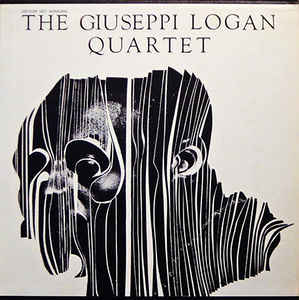
The Giuseppi Logan Quartet is an album by American jazz saxophonist Giuseppi Logan, recorded at Bell Sound Studios in 1964 and released in 1965 on the ESP-Disk label. His first recording as leader, it features Logan on alto saxophone, tenor saxophone, Pakistani oboe, bass clarinet, and flute along with pianist Don Pullen, bassist Eddie Gómez, and drummer Milford Graves. Logan had moved to New York City in September 1964, and the recording took place shortly after the October Revolution in Jazz, at which Logan performed, and during which he met ESP-Disk founder Bernard Stollman. According to Logan, the musicians had not played together prior to the recording session.
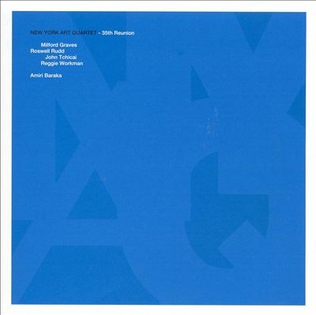
35th Reunion is the third album by the New York Art Quartet. It was recorded at Avatar Studios in New York City on June 14, 1999, and was released in 2000 by DIW Records. It features John Tchicai on alto saxophone, Roswell Rudd on trombone, Reggie Workman on bass, and Milford Graves on percussion. Amiri Baraka, whose poem "Black Dada Nihilismus" was included on the group's debut album, also appears.

More is the second album by American jazz saxophonist Giuseppi Logan, recorded in May 1965 and released in 1966 by the ESP-Disk label. The album features Logan on alto saxophone, bass clarinet, flute, and piano along with pianist Don Pullen, bassists Eddie Gómez and Reggie Johnson, and drummer Milford Graves.

Bäbi is a live album by American percussionist Milford Graves, recorded in March 1976 and released in 1977 by the Institute of Percussive Studies, a label owned and run by Graves and Andrew Cyrille. The album features Graves on drums and percussion, along with reed players Arthur Doyle and Hugh Glover.

Historic Music Past Tense Future is a double-LP live album by saxophonist Peter Brötzmann, drummer Milford Graves, and bassist William Parker. It was recorded in March 2002 at CB's 313 Gallery in New York City, and was released in 2022 by Black Editions Archive, a label focused on historical free jazz, with emphasis on the release of previously unavailable recordings by Graves.
















